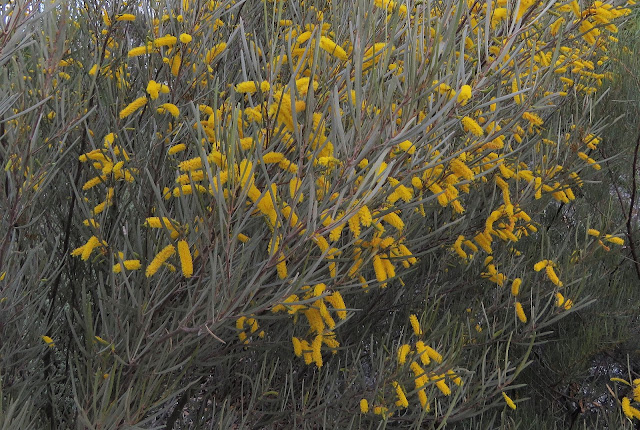Furled mulga brandishing baleful besoms [repost]
Our Umbrella Mulga doesn't get much of a change to unfurl in the skinny Diversity Garden at the edge of the Australian Garden, but the bright yellow flower spikes against the dull grey foliage are attractive even in this constrained state.
Acacia brachystachya is one of the 'mulgas' found throughout arid inland Australia. The species name refers to the short (brachy-) flowering spikes (-stachya), although they reach three centimetres long which is not so that short for a wattle or unlike similar looking mulgas.
The species was named by English Botanist George Benson from a specimen collected by Hermann Beckler from 'Yaginya Mountains' (the Mutawintji/Mootwingie Range in western News South Wales). Beckler travelled with Burke and Wills as far as Menindie (a little south of the range), thus surviving that ill-fated trip.
Our plant features in in a ribbon garden devoted to plants from the Simpson Strzelecki Dunefields bioregion, a geographical grouping found in the centre of Australia near the borders of Northern Territory, Queensland and New South Wales. The vegetation consists mostly of spinifex, a few gum trees and wattles such as the Umbrella Mulga. All atop or flanking long, parallel sand dunes.
As with most (but not all) Australian wattles, the seed is edible. Because the seed of the Umbrella Mulga is more than twice the size of most wattle seed its an attractive food proposition. Against that is the very hard, thick seed coat, and its attractiveness to insects who often get there first.
The pods carrying these seeds, when present, are helpful in distinguishing this species from other mulgas. They are straight, a little flattened and with distinctive yellowish raised lines (veins) along the length of the pod.
In May our plant were podless, but had an additional attraction, or distraction - a Witches' Broom. This distortion of branches and leaves (often slightly miniaturised) due to a hormone change in the plant is a response by the plant to an insect, fungus or (most often I think) a bacterium called a phytoplasma.
Mostly though, the plant has a beautiful grey hue, offset by the - I would say - perfectly-sized yellow flower spikes.
Note: If this looks familiar, you may have seen it back in July when it got posted by mistake on the same day as the controversial Choko story... I'm giving it its own Tuesday slot today. Enjoy (perhaps again).





Comments